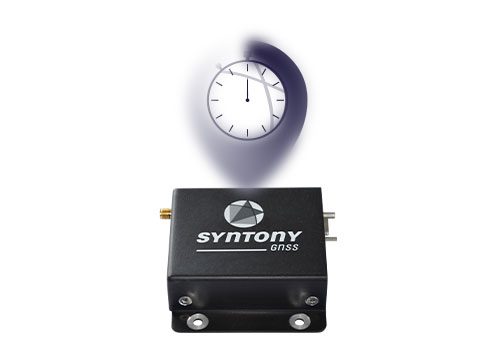GNSS Receiver Start Modes Explained: Debunking Common Myths
Global Navigation Satellite System (GNSS) receivers have become an integral part of modern technology, embedded in smartphones, vehicles, and various industries. However, there’s a common misconception that GNSS receivers provide immediate positioning with centimeter-level precision. In reality, GNSS receivers need to go through different start modes—cold, warm, and hot—each impacting the time to first fix (TTFF), or the time it takes for the receiver to compute its initial position.
Cold Start Mode – The Longest Wait for Precision
When a GNSS receiver is turned on for the first time or has been off for an extended period, it enters what is known as cold start mode. In this mode, the receiver has no a priori information about its location, the satellite positions (ephemeris data), or the current time. As a result, the receiver has no knowledge of the satellite in view and must search across the entire GNSS constellations as well as download accurate time and ephemeris information for at least 4 satellites in order to be able to compute a navigation solution.
The cold start process begins with the receiver attempting to lock onto any available GNSS satellites. This involves downloading the almanac, which provides a rough location of all satellites in the sky, but more importantly, the ephemeris data, which contains precise information about each satellite’s orbit. Only after acquiring enough satellites and the necessary data can the receiver compute an accurate position. This lengthy process is why the cold start mode is the slowest and most resource-intensive.
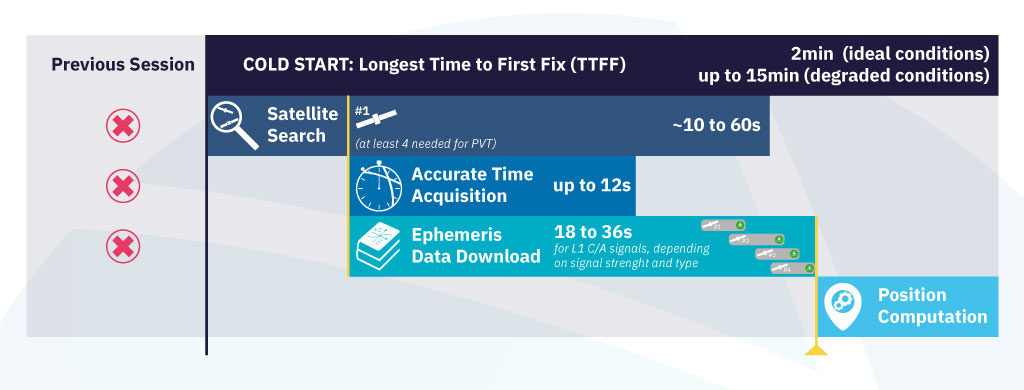
Warm Start Mode – A Faster Alternative
Warm start mode occurs when a GNSS receiver has some residual information from a previous session, such as a rough estimate of its last known position, time, and satellite data. Consequently, the receiver searches only for satellites in view but must still download ephemeris and accurate time information from the GNSS constellations. The TTFF in warm start mode is typically taking about the same time as cold start, but the advantages come from the fact that the receiver does not search across the entire GNSS constellations as satellites in view are known. Nowadays, it is particularly effective in poor startup conditions, although it was originally most beneficial when the acquisition process itself took much longer.
Warm start mode relies on the availability of stored almanac and clock data, which allows the receiver to quickly reacquire satellites and update its ephemeris data. The improved startup time makes warm mode suitable for scenarios where the receiver has been off for a short period or has moved only slightly from its last known position. While not as fast as hot start mode, warm start strikes a balance between speed and the accuracy needed for various applications.
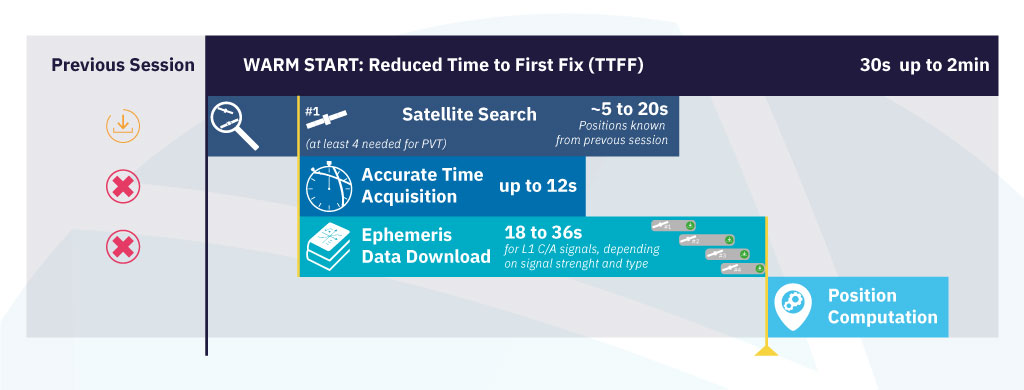
Hot Start Mode – Nearly Instantaneous Positioning
Hot start mode is the quickest of the three start modes, offering a TTFF of just a few seconds. In this mode, the receiver retains nearly all relevant information from its last session, including its previous position, accurate time, and up-to-date ephemeris data. As a result, the receiver can quickly reestablish connections with satellites and provide an accurate position almost instantaneously.
This rapid startup is ideal for devices that are frequently used and are only briefly turned off or moved. For instance, in vehicle navigation systems, a hot start mode ensures that the receiver provides prompt positioning when the vehicle resumes movement after a short stop. Despite the efficiency of hot start mode, it’s crucial to remember that it still requires a moment to verify satellite signals and ensure the accuracy of the provided position data.
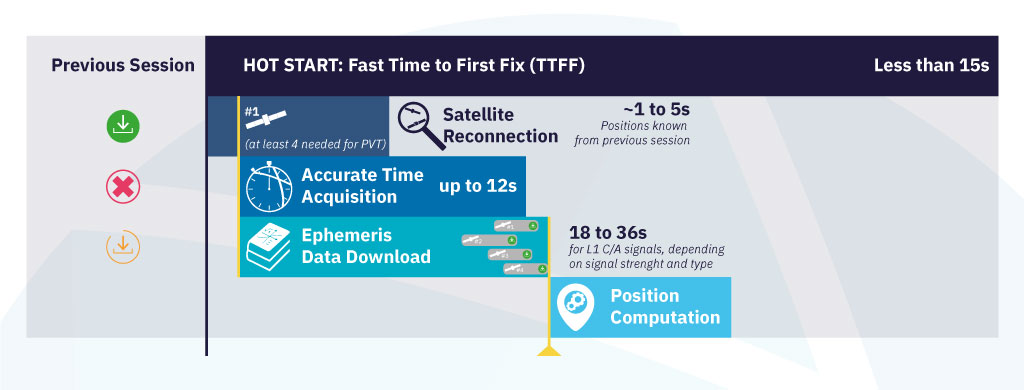
Direct Tracking Mode – Real-Time, Continuous Updates
Direct tracking mode is an advanced operational mode in GNSS receivers, designed to provide real-time, uninterrupted position updates. Unlike the start modes that activate when a receiver is turned on, direct tracking continuously monitors satellite signals without interruption. This mode ensures that as long as the receiver remains powered, it actively updates its position in real time, making it ideal for dynamic environments and high-speed movements.
Direct tracking mode is particularly valuable in applications where instant reaction times are crucial, such as in aerospace, mining operations, or transportation systems. By maintaining a constant connection with satellites, the receiver can seamlessly adjust to changes in position and speed without needing to reinitialize or reacquire satellite data. This continuous tracking ensures that positioning data is always current, reducing latency and improving accuracy significantly.
Therefore, one of the main benefits of direct tracking is its resilience in environments where signal conditions fluctuate. Even in partially obstructed areas, the receiver maintains its link with as many satellites as possible, minimizing downtime and ensuring that position updates are as real-time as the conditions allow.
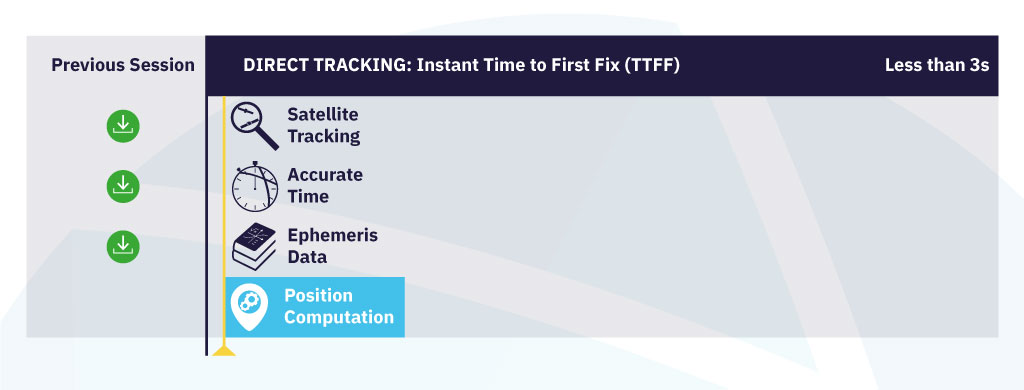
Enhancing GNSS Performance with SubWAVE Technology
While GNSS receivers are generally reliable, they can struggle in challenging environments, particularly underground and in tunnels, where satellite signals are obstructed. This is where innovative solutions like SubWAVE come into play. SubWAVE extends GNSS signal coverage into environments where traditional signals cannot reach, providing GNSS receivers with the necessary data even when satellites are not naturally visible.
For instance, consider a train stopping through an underground marshalling yard. Without SubWAVE, the train’s GNSS receiver would enter cold start mode upon exiting the tunnel, requiring a significant amount of time to gather satellite data and establish a position (maintaining low speed for a while, hence affecting operations efficiency).
However, with SubWAVE, the receiver can gather critical ephemeris and timing data while still in the tunnel or at a station, effectively initializing the receiver before it’s exposed to open sky. As a result, once the train exits the tunnel, the receiver is already in warm or hot start mode, allowing it to acquire GNSS data rapidly and maintain accurate positioning. This capability not only enhances the safety and efficiency of train control systems but also reinforces GNSS’s status as the most reliable global positioning technology available today.
If you have questions about our GNSS positioning solutions, feel free to contact us.
